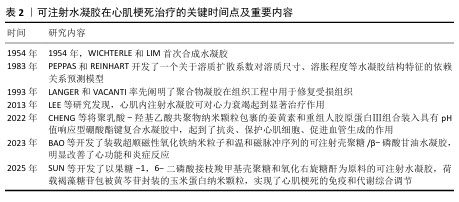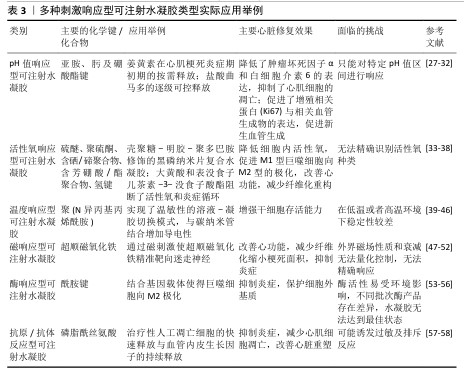[1] GLADKA MM, KOHELA A, MOLENAAR B,
et al. Cardiomyocytes stimulate angiogenesis after ischemic injury in a ZEB2-dependent manner. Nat Commun. 2021;12(1):84.
[2] ALIZADEH G, GHOLIPOUR K, KAZEMI SHISHAVAN M, et al. Future of myocardial infarction mortality in Iran: a scenario-based study. J Health Popul Nutr. 2023;42(1):19.
[3] ZHENG Z, TAN Y, LI Y, et al. Biotherapeutic-loaded injectable hydrogels as a synergistic strategy to support myocardial repair after myocardial infarction. J Control Release. 2021;335:216-236.
[4] FRANGOGIANNIS NG. Pathophysiology of Myocardial Infarction. Compr Physiol. 2015; 5(4):1841-1875.
[5] SEROPIAN IM, TOLDO S, VAN TASSELL BW, et al. Anti-inflammatory strategies for ventricular remodeling following ST-segment elevation acute myocardial infarction. J Am Coll Cardiol. 2014;63(16):1593-1603.
[6] NAHRENDORF M, PITTET MJ, SWIRSKI FK. Monocytes: protagonists of infarct inflammation and repair after myocardial infarction. Circulation. 2010;121(22): 2437-2445.
[7] SWIRSKI FK, NAHRENDORF M. Macrophage-stem cell crosstalk after myocardial infarction. J Am Coll Cardiol. 2013;62(20):1902-1904.
[8] BEJERANO T, ETZION S, ELYAGON S, et al. Nanoparticle Delivery of miRNA-21 Mimic to Cardiac Macrophages Improves Myocardial Remodeling after Myocardial Infarction. Nano Lett. 2018;18(9):5885-5891.
[9] CHEN J, YANG J, LIU R, et al. Dual-targeting Theranostic System with Mimicking Apoptosis to Promote Myocardial Infarction Repair via Modulation of Macrophages. Theranostics. 2017;7(17):4149-4167.
[10] DAI Y, SONG J, LI W, et al. RhoE Fine-Tunes Inflammatory Response in Myocardial Infarction. Circulation. 2019;139(9): 1185-1198.
[11] NGUYEN PD, DE BAKKER DEM, BAKKERS J. Cardiac regenerative capacity: an evolutionary afterthought? Cell Mol Life Sci. 2021;78(12):5107-5122.
[12] MORSINK M, SEVERINO P, LUNA-CERON E, et al. Effects of electrically conductive nano-biomaterials on regulating cardiomyocyte behavior for cardiac repair and regeneration. Acta Biomater. 2022;139: 141-156.
[13] BORGES FTP, PAPAVASILIOU G, TEYMOUR F. Characterizing the Molecular Architecture of Hydrogels and Crosslinked Polymer Networks beyond Flory-Rehner-I. Theory. Biomacromolecules. 2020;21(12): 5104-5118.
[14] KOETTING MC, PETERS JT, STEICHEN SD,
et al. Stimulus-responsive hydrogels: Theory, modern advances, and applications. Mater Sci Eng R Rep. 2015;93:1-49.
[15] SLAUGHTER BV, KHURSHID SS, FISHER OZ,
et al. Hydrogels in regenerative medicine. Adv Mater. 2009;21(32-33):3307-3329.
[16] BERTSCH P, DIBA M, MOONEY DJ, et al. Self-Healing Injectable Hydrogels for Tissue Regeneration. Chem Rev. 2023;123(2): 834-873.
[17] CORREA S, GROSSKOPF AK, LOPEZ HERNANDEZ H, et al. Translational Applications of Hydrogels. Chem Rev. 2021; 121(18):11385-11457.
[18] 高晨珊,张亚莉,侯磊.可注射水凝胶治疗心肌梗死[J].国际心血管病杂志,2023, 50(1):9-12.
[19] LEE LC, WALL ST, KLEPACH D, et al. Algisyl-LVR™ with coronary artery bypass grafting reduces left ventricular wall stress and improves function in the failing human heart. Int J Cardiol. 2013;168(3):2022-2028.
[20] MELLATI A, HASANZADEH E, GHOLIPOURMALEKABADI M, et al. Injectable nanocomposite hydrogels as an emerging platform for biomedical applications: A review. Mater Sci Eng C Mater Biol Appl. 2021;131:112489.
[21] 李树成,郭炳辰,高殿钰,等.可注射水凝胶在慢性心力衰竭治疗中的前景与挑战[J].中国介入心脏病学杂志,2024, 32(8):451-456.
[22] LIAO J, HOU B, HUANG H. Preparation, properties and drug controlled release of chitin-based hydrogels: An updated review. Carbohydr Polym. 2022;283:119177.
[23] MO C, LUO R, CHEN Y. Advances in the Stimuli-Responsive Injectable Hydrogel for Controlled Release of Drugs. Macromol Rapid Commun. 2022;43(10):e2200007.
[24] ZHANG L, BEI Z, LI T, et al. An injectable conductive hydrogel with dual responsive release of rosmarinic acid improves cardiac function and promotes repair after myocardial infarction. Bioact Mater. 2023;29:132-150.
[25] 郑月丹,王晓玲,冯俊峰,等.刺激响应型可注射水凝胶在药物控释领域的研究进展[J].分子材料科学与工程,2024, 40(9):164-172.
[26] 吕永波,王娟.干细胞在治疗急性心肌梗死中应用的研究进展[J].中国临床新医学,2024,17(9):1061-1065.
[27] ZHAO L, NIU L, LIANG H, et al. pH and Glucose Dual-Responsive Injectable Hydrogels with Insulin and Fibroblasts as Bioactive Dressings for Diabetic Wound Healing. ACS Appl Mater Interfaces. 2017; 9(43):37563-37574.
[28] VEGAD U, PATEL M, KHUNT D, et al. pH stimuli-responsive hydrogels from non-cellulosic biopolymers for drug delivery. Front Bioeng Biotechnol. 2023; 11:1270364.
[29] DAI S, RAVI P, TAM KC. pH-Responsive polymers: synthesis, properties and applications. Soft Matter. 2008;4(3): 435-449.
[30] KWON SS, KONG BJ, PARK SN. Physicochemical properties of pH-sensitive hydrogels based on hydroxyethyl cellulose-hyaluronic acid and for applications as transdermal delivery systems for skin lesions. Eur J Pharm Biopharm. 2015;92: 146-154.
[31] HU C, LIU W, LONG L, et al. Regeneration of infarcted hearts by myocardial infarction-responsive injectable hydrogels with combined anti-apoptosis, anti-inflammatory and pro-angiogenesis properties. Biomaterials. 2022;290:121849.
[32] NOUREEN S, NOREEN S, GHUMMAN SA, et al. A novel pH-responsive hydrogel system based on Prunus armeniaca gum and acrylic acid: Preparation and evaluation as a potential candidate for controlled drug delivery. Eur J Pharm Sci. 2023;189:106555.
[33] KORNFELD OS, HWANG S, DISATNIK MH,
et al. Mitochondrial reactive oxygen species at the heart of the matter: new therapeutic approaches for cardiovascular diseases. Circ Res. 2015;116(11):1783-1799.
[34] GAO F, XIONG Z. Reactive Oxygen Species Responsive Polymers for Drug Delivery Systems. Front Chem. 2021;9:649048.
[35] REGATO-HERBELLA M, MORHENN I, MANTIONE D, et al. ROS-Responsive 4D Printable Acrylic Thioether-Based Hydrogels for Smart Drug Release. Chem Mater. 2024;36(3):1262-1272.
[36] PU M, CAO H, ZHANG H, et al. ROS-responsive hydrogels: from design and additive manufacturing to biomedical applications. Mater Horiz. 2024;11(16): 3721-3746.
[37] ZHANG J, SUN D, LIAO Y, et al. Time-Released Black Phosphorus Hydrogel Accelerates Myocardial Repairing through Antioxidant and Motivates Macrophage Polarization Properties. Biomater Res. 2024; 28:0029.
[38] LIAO X, SONG X, LI J, et al. An injectable co-assembled hydrogel blocks reactive oxygen species and inflammation cycle resisting myocardial ischemia-reperfusion injury. Acta Biomater. 2022;149:82-95.
[39] PERTICI V, PIN-BARRE C, RIVERA C, et al. Degradable and Injectable Hydrogel for Drug Delivery in Soft Tissues. Biomacromolecules. 2019;20(1):149-163.
[40] SURYAVANSHI P, MAHAJAN S, BANERJEE SK, et al. Synthesis and characterization of a pH/temperature-dual responsive hydrogel with promising biocompatibility features for stimuli-responsive 5-FU delivery. J Mater Chem B. 2024;12(21):5098-5110.
[41] CHOI JH, LEE JS, YANG DH, et al. Development of a Temperature-Responsive Hydrogel Incorporating PVA into NIPAAm for Controllable Drug Release in Skin Regeneration. ACS Omega. 2023;8(46):44076-44085.
[42] ROH YH, MOON JY, HONG EJ, et al. Microfluidic fabrication of biocompatible poly(N-vinylcaprolactam)-based microcarriers for modulated thermo-responsive drug release. Colloids Surf B Biointerfaces. 2018;172:380-386.
[43] LI P, HU J, WANG J, et al. The Role of Hydrogel in Cardiac Repair and Regeneration for Myocardial Infarction: Recent Advances and Future Perspectives. Bioengineering (Basel). 2023;10(2):165.
[44] CAO Y, FAN R, ZHU K, et al. Advances in Functionalized Hydrogels in the Treatment of Myocardial Infarction and Drug-Delivery Strategies. ACS Appl Mater Interfaces. 2024;16(37):48880-48894.
[45] LIANG J, LV R, LI M, et al. Hydrogels for the Treatment of Myocardial Infarction: Design and Therapeutic Strategies. Macromol Biosci. 2024;24(2):e2300302.
[46] LI X, ZHOU J, LIU Z, et al. A PNIPAAm-based thermosensitive hydrogel containing SWCNTs for stem cell transplantation in myocardial repair. Biomaterials. 2014; 35(22):5679-5688.
[47] HUANG S, FRANGOGIANNIS NG. Anti-inflammatory therapies in myocardial infarction: failures, hopes and challenges. Br J Pharmacol. 2018;175(9):1377-1400.
[48] YU J, ZHANG RF, MAO YL. Cerebellar fastigial nucleus electrostimulation attenuates inflammation in a Post-Infarction rat model by activating cholinergic anti-inflammatory pathway. Neurosci Lett. 2022;788:136860.
[49] CHEN M, WANG S, LI X, et al. Non-invasive Autonomic Neuromodulation Is Opening New Landscapes for Cardiovascular Diseases. Front Physiol. 2020;11:550578.
[50] SOMANN JP, ALBORS GO, NEIHOUSER KV,
et al. Chronic cuffing of cervical vagus nerve inhibits efferent fiber integrity in rat model. J Neural Eng. 2018;15(3):036018.
[51] WANG M, YIN Y. Magnetically Responsive Nanostructures with Tunable Optical Properties. J Am Chem Soc. 2016;138(20): 6315-6323.
[52] BAO S, LU Y, ZHANG J, et al. Rapid improvement of heart repair in rats after myocardial infarction by precise magnetic stimulation on the vagus nerve with an injectable magnetic hydrogel. Nanoscale. 2023;15(7):3532-3541.
[53] Kono H, Otaka F, Ozaki M. Preparation and characterization of guar gum hydrogels as carrier materials for controlled protein drug delivery. Carbohydr Polym. 2014; 111:830-840.
[54] THAMBI T, PHAN VH, LEE DS. Stimuli-Sensitive Injectable Hydrogels Based on Polysaccharides and Their Biomedical Applications. Macromol Rapid Commun. 2016;37(23):1881-1896.
[55] CHEN X, LIU Z. A pH-Responsive Hydrogel Based on a Tumor-Targeting Mesoporous Silica Nanocomposite for Sustained Cancer Labeling and Therapy. Macromol Rapid Commun. 2016;37(18):1533-1539.
[56] CHEN W, WANG C, LIU W, et al. A Matrix-Metalloproteinase-Responsive Hydrogel System for Modulating the Immune Microenvironment in Myocardial Infarction. Adv Mater.2023;35(13):e2209041.
[57] ACCIARETTI F, VESENTINI S, CIPOLLA L. Fabrication Strategies Towards Hydrogels for Biomedical Application: Chemical and Mechanical Insights. Chem Asian J. 2022;17(22):e202200797.
[58] ZHANG X, LYU Y, LIU Y, et al. Artificial apoptotic cells/VEGF-loaded injectable hydrogel united with immunomodification and revascularization functions to reduce cardiac remodeling after myocardial infarction. Nano Today. 2021;39:101227.
[59] MORONI L, BOLAND T, BURDICK JA, et al.
Biofabrication: A Guide to Technology and Terminology. Trends Biotechnol. 2018; 36(4):384-402.
[60] JAFARI A, AJJI Z, MOUSAVI A, et al. Latest Advances in 3D Bioprinting of Cardiac Tissues. Adv Mater Technol. 2022;7(11): 2101636.
[61] FATIMI A, OKORO OV, PODSTAWCZYK D,
et al. Natural Hydrogel-Based Bio-Inks for 3D Bioprinting in Tissue Engineering: A Review. Gels. 2022;8(3):179.
[62] TAMAY DG, DURSUN USAL T, ALAGOZ AS,
et al. 3D and 4D Printing of Polymers for Tissue Engineering Applications. Front Bioeng Biotechnol. 2019;7:164.
[63] KABIRIAN F, MELA P, HEYING R. 4D Printing Applications in the Development of Smart Cardiovascular Implants. Front Bioeng Biotechnol. 2022;10:873453.
[64] 黄宇翔,李琪,叶武,等.生物4D打印技术在心血管组织工程中的研究及应用进展[J].生物工程学报,2023,39(10): 4046-4056.
[65] FABER L, YAU A, CHEN Y. Translational biomaterials of four-dimensional bioprinting for tissue regeneration. Biofabrication. 2024;16(1):012001.
[66] CHATTERJEE S, HUI PC. Review of Applications and Future Prospects of Stimuli-Responsive Hydrogel Based on Thermo-Responsive Biopolymers in Drug Delivery Systems. Polymers (Basel). 2021; 13(13):2086.
[67] 张雅楠,许锋.心脏脱细胞基质水凝胶制备及其对心肌梗死修复的研究进展[J].心血管病学进展,2023,44(9):823-827.
[68] SUN Y, ZHAO X, ZHANG Q, et al. An immunoregulatory and metabolism-improving injectable hydrogel for cardiac repair after myocardial infarction. Regen Biomater. 2025;12:rbae131.
[69] ISHIKAWA K. The Transgenic Diabetic Pig Heart: A “Sweet Heart” for Translational Cardiovascular Research. J Am Coll Cardiol. 2017;69(2):144-146. |





